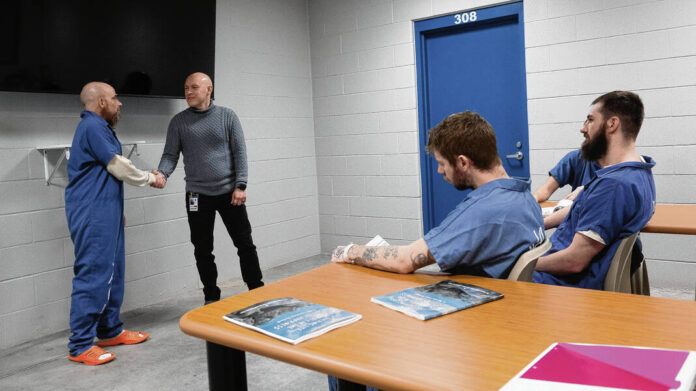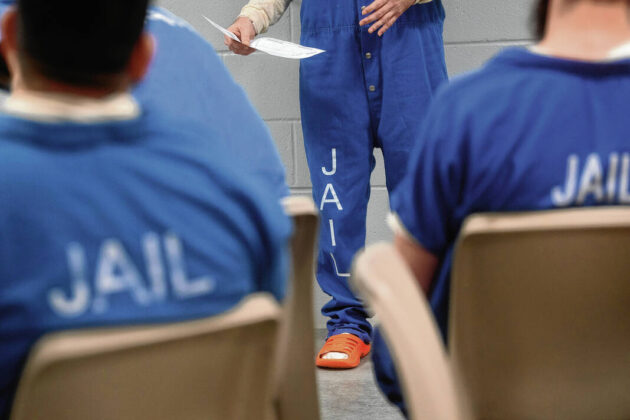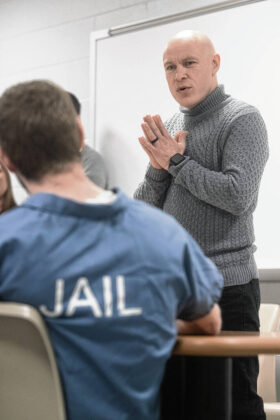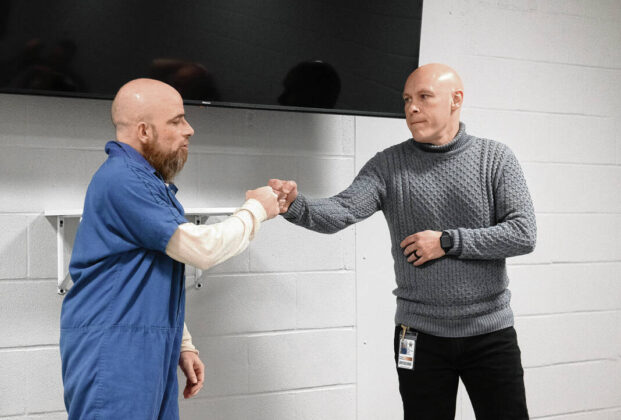
Hancock County Jail inmate Joshua Thomas, left, shakes hands with Matthew Graham, a moral reconation therapy provider, during a session at the jail on Feb. 16.
Tom Russo | Daily Reporter
HANCOCK COUNTY – Joshua Davidson stood in a classroom before about a dozen of his fellow inmates at the Hancock County Jail.
He was in a session for a therapy program from which he recently graduated and that he continues attending to help others making their way through.
“We’re not bad people,” he said, “we just made bad choices.”
It was one of several times Davidson brought up making bad choices during the session.
But there was plenty of evidence to the contrary, those working for the jail pointed out.
“You’ve been making a lot of good choices,” Crystal Petty told him, standing in the back of the classroom wearing her ID badge.
Helping Davidson and other inmates as they make those good choices is a navigation initiative that’s been part of the county’s new jail since last June. That service helps those incarcerated get into programs while they’re in jail and meet needs they have when they’re released. The goal is to reduce recidivism and help participants lead better lives, while also easing strain on the justice system and creating a safer community. With the jail not even a year old, the initiative is already having a positive impact, according to those providing and receiving the services.
Navigating new territory
Workers called navigators provide the assistance. Two work for the jail helping inmates, while one employed by Greenfield-based Healthy365 comes in as inmates are being released and continues as they reenter the community.
The county budgeted for navigation at the jail and approved $2.5 million in American Rescue Plan funds for the external navigation over the next several years.
Petty, one of the jail navigators, has a bachelor’s degree in sociology and worked for the Department of Child Services for 16 years. In her role at the jail, she conducts an intake and assessment process with inmates to identify their needs and long-term goals.
Substance use and mental health are typically the top two needs, Petty said. Others include employment, transportation, housing, insurance and health care.
Petty connects inmates to resources outside the jail to help meet those needs and also coordinates programs inside the facility, which address high school equivalency, addiction recovery, parenting, jail intervention, moral reconation therapy, church and peer recovery coaching.
The workload has grown so much that a second navigator is now joining Petty at the jail.
When the navigation program first started last year, Petty was reaching out to those sentenced to serve time in the jail. Word quickly spread, however, and soon those in need of her help were reaching out to her.
As of last week, Petty had met with about 370 inmates – 30% of the jail’s population since she started.
Connor McCarty is the navigator with Healthy365 who helps those as they’re getting ready to be released from the jail and after they’ve left. Social work has been his profession for about eight years, much of which with the Department of Child Services.
For those transitioning out of jail in need of support or resources in the community, McCarty is there to help fill the gaps. Like Petty, he works to determine what their needs are and helps build a plan specific to them. That could include walking alongside them to complete a Medicaid application, letting them know what addiction recovery groups are available in the area, helping them secure treatment that picks up from where they left off in programs at the jail, or working with mental health and substance use treatment providers that restructure their intake processes to accommodate inmates unable to participate in a traditional interview.
“We’re doing something that’s not been done before in Hancock County – providing that navigation and that support for individuals reentering our community,” he said. “We’re able to create that process where somebody can work with Crystal inside the jail, identify they need recovery resources, they need a place to live, and they need employment, and instead of trying to figure out all that on their own, they’re able to work with us and we’re able to help provide that road map through those resources for them.”
Both navigators work closely with one another.
“As people are getting closer to getting released, Connor’s going back there to the pods with me too and talking and meeting with people,” Petty said.
McCarty said he often hears from those he’s working with that they did not know resources were available to them for needs like employment and recovery.
“That’s pretty great to hear – I’m spreading that awareness,” he said.
Housing and transportation are often challenging necessities to help meet.
“Those are unfortunately huge needs in our community that we don’t necessarily have the resources available, and so we have to be really creative and work with outside-county resources to get those needs met,” McCarty said, adding he enjoys the opportunity to be an advocate for those needs in the community.
While Petty and McCarty have seen the benefits of the navigation firsthand, they also acknowledged it doesn’t work out in every case.
“I think it has to do with people wanting things to be different, but not necessarily being ready for that change, or taking that initiative to make that change,” Petty said.
Hancock County Sheriff Brad Burkhart said he’s ecstatic over the collaboration that brought the navigation initiative to fruition – a vision that began seven years ago.
“Years of seeing that back-and-forth when somebody who gets out of jail comes back because they go back into that same environment that they went into because that’s what they knew – they went right back in jail,” Burkhart said. “It’s just, like, why can’t we change this?”
‘A different route’
During a break from their therapy session, Davidson and other inmates reflected on the resources they’ve been connected to via the navigation program, including housing, clothes and jobs.
“Crystal, she does help with everything – health insurance, food, clothing, shelter, stuff like that,” Davidson said. “People need it. It’s good to see, because most of us in here, it seems like everything works against us, that we don’t ever have a chance, and I think that this is a chance for us people.”
Benjamin Staletovich has been incarcerated in other jails that lack what Hancock County offers and said the results are not surprising.
“When people get arrested, they come to jail, and then once they get released, like out of every other county I’ve ever been to – there’s no programs available,” he said. “There’s absolutely nothing changing besides the time that they’ve done. So when they get back out, they’re going exactly back to where they were. They’re going back to what they know, back to what they’re good at, back to what got them to where they are.”
Hancock County’s jail and the services it provides offer an opportunity to break that cycle, Staletovich continued.
“It gives people the chance of going a different route than the route that they’re so used to,” he said.
Danielle Brashear, 28, is serving time in the Hancock County Jail for a probation violation after being convicted of possession of methamphetamine and other charges in 2020. She is grateful for the programs she participates in, like moral reconation therapy, parenting, and anger management, as well as meeting with a peer recovery coach.
She appreciates Petty’s guidance along the way.
“As someone who doesn’t have a normal support system and whose support system started to develop around riffraff, and just the wrong environment – it’s not really support,” Brashear said. “She makes me feel like I have a friend. I don’t even know how to explain it. She makes me feel like somebody cares about me, and she makes me feel like I have a support system.”
Brashear giddily met McCarty, who will join her support system as her release date nears.
“This new jail is worth it, these new programs are worth it,” she said, adding she hopes it’s not viewed as a waste of taxpayer money. “I want to say thank you to the people who supported this, even if they didn’t know what they were supporting. They’re making life changes, for real.”







